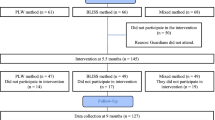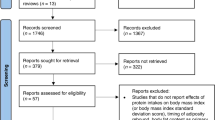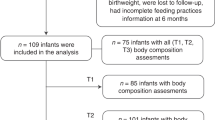Abstract
The determinants of childhood overweight and obesity are complex, but infant feeding and the early diet are important contributing factors. The complementary feeding period in particular, is a time during which children are nutritionally vulnerable, and a time where life-long eating habits may be established. We conducted a systematic review of the literature that investigated the relationship between the types of food consumed by infants during the complementary feeding period and overweight or obesity during childhood. Electronic databases were searched from inception until June 2012 using specified keywords. Following the application of strict inclusion/exclusion criteria, 10 studies were identified and reviewed by two independent reviewers. Data were extracted and aspects of quality were assessed using an adapted Newcastle–Ottawa scale. Studies were categorised into three groups: macronutrient intake, food type/group and adherence to dietary guidelines. Some association was found between high protein intakes at 2–12 months of age and higher body mass index (BMI) or body fatness in childhood, but was not the case in all studies. Higher energy intake during complementary feeding was associated with higher BMI in childhood. Adherence to dietary guidelines during weaning was associated with a higher lean mass, but consuming specific foods or food groups made no difference to children’s BMI. We concluded that high intakes of energy and protein, particularly dairy protein, in infancy could be associated with an increase in BMI and body fatness, but further research is needed to establish the nature of the relationship. Adherence to dietary guidelines during weaning is recommended.
This is a preview of subscription content, access via your institution
Access options
Subscribe to this journal
Receive 12 print issues and online access
$259.00 per year
only $21.58 per issue
Buy this article
- Purchase on Springer Link
- Instant access to full article PDF
Prices may be subject to local taxes which are calculated during checkout

Similar content being viewed by others
References
World Health Organzation. World Health Report: Reducing Risks, Promoting Healthy Life. Geneva 2002.
International Association for the Study of Obesity. London (2012), available at http://www.iaso.org/site_media/library/resource_images/Childhood_overweight_and_obesity_by_Region.pdf (accessed Aug 2012).
Singh AS, Mulder C, Twisk JW, van Mechelen W, Chinapaw MJ . Tracking of childhood overweight into adulthood: a systematic review of the literature. Obes Rev 2008; 9: 474–488.
Swinburn B, Shelly A . Effects of TV time and other sedentary pursuits. Int J Obes (Lond) 2008; 32 (Suppl 7): S132–S136.
Hills AP, Andersen LB, Byrne NM . Physical activity and obesity in children. Br J Sports Med 2011; 45: 866–870.
Guran T, Bereket A . International epidemic of childhood obesity and television viewing. Minerva Pediatr 2011; 63: 483–490.
Keane E, Layte R, Harrington J, Kearney PM, Perry IJ . Measured parental weight status and familial socio-economic status correlates with childhood overweight and obesity at age 9. PLoS One 2012; 7: e43503.
Kendzor DE, Caughy MO, Owen MT . Family income trajectory during childhood is associated with adiposity in adolescence: a latent class growth analysis. BMC Public Health 2012; 12: 611.
Gregori D, Foltran F, Ghidina M, Zobec F, Berchialla P . Familial environment in high- and middle-low-income municipalities: a survey in Italy to understand the distribution of potentially obesogenic factors. Public Health 2012; 126: 731–739.
Fiese BH, Hammons A, Grigsby-Toussaint D . Family mealtimes: a contextual approach to understanding childhood obesity. Econ Hum Biol 2012; 10: 365–374.
Beyerlein A, von Kries R . Breastfeeding and body composition in children: will there ever be conclusive empirical evidence for a protective effect against overweight? Am J Clin Nutr 2011; 94 (Suppl 6): 1772S–1775S.
WHO. Report of the Expert Consultation of the Optimal Duration of Exclusive Breastfeeding. WHO: Geneva, Switzerland, 2001.
Department of Health. In NHS (ed). Weaning: Starting Solid Food. UK: Department of Health, 2008.
Pearce J, Langley-Evans SC . Timing of complementary food introduction and the risk of childhood obesity: a systematic review. Int J Obes (Paper submitted).
Kuczmarski RJ, Ogden CL, Grummer-Strawn LM, Flegal KM, Guo SS, Wei R et al. CDC growth charts: United States. Adv Data 2000; 1–27.
Cole TJ, Bellizzi MC, Flegal KM, Dietz WH . Establishing a standard definition for child overweight and obesity worldwide: international survey. Br Med J 2000; 320: 1240–1243.
Obesity: preventing and managing the global epidemic. Report of a WHO consultation. World Health Organ Tech Rep Ser 2000; 894, i-xii 1–253.
Wells GA, Shea B, O’Connell D, Peterson J, Welch V, Losos M et al. The Newcastle-Ottawa Scale (NOS) for assessing the quality of nonrandomised studies in meta-analyses. In 2011.
Gunnarsdottir I, Thorsdottir I . Relationship between growth and feeding in infancy and body mass index at the age of 6 years. Int J Obes 2003; 27: 1523–1527.
Gunther AL, Buyken AE, Kroke A . Protein intake during the period of complementary feeding and early childhood and the association with body mass index and percentage body fat at 7 y of age. Am J Clin Nutr 2007; 85: 1626–1633.
Gunther ALB, Remer T, Kroke A, Buyken AE . Early protein intake and later obesity risk: which protein sources at which time points throughout infancy and childhood are important for body mass index and body fat percentage at 7 y of age? Am J Clin Nutr 2007; 86: 1765–1772.
Hoppe C, Molgaard C, Thomsen BL, Juul A, Michaelsen KF . Protein intake at 9 mo of age is associated with body size but not with body fat in 10-y-old Danish children. Am J Clin Nutr 2004; 79: 494–501.
Ong KK, Emmett PM, Noble S, Ness A, Dunger DB, Team AS . Dietary energy intake at the age of 4 months predicts postnatal weight gain and childhood body mass index. Pediatrics 2006; 117: E503–E508.
Mills A . Food Standards Agency: Food Portion Sizes. TSO: London, 2002.
Robinson SM, Marriott LD, Crozier SR, Harvey NC, Gale CR, Inskip HM et al. Variations in infant feeding practice are associated with body composition in childhood: a prospective cohort study. J Clin Endocrinol Metab 2009; 94: 2799–2805.
Kanoa BJ, Zabut BM, Harried AT . Nutritional status compared with nutritional history of preschool aged children in gaza strip: cross sectional study. Pakistan J Nutr 2011; 10: 282–290.
Santos IS, Matijasevich A, Valle NCJ, Gigante DP, de Moura DR . Milk thickeners do not influence anthropometric indices in childhood. Food Nuts Bull 2006; 27: 245–251.
Schack-Nielsen L, Sørensen TIA, Mortensen EL, Michaelsen KF . Late introduction of complementary feeding, rather than duration of breastfeeding, may protect against adult overweight. Am J Clin Nutr 2010; 91: 619–627.
Simon VGN, de Souza JMP, de Souza SB . Breastfeeding, complementary feeding, overweight and obesity in pre-school children. Rev Saude Publica 2009; 43: 60–69.
WHO. A Growth Chart for International Use in Maternal and Child Health Care: Guidelines for Primary Health Care Personnel Geneva: WHO; London: HMSO: 1978.
Moore AP, Milligan P, Goff LM . An online survey of knowledge of the weaning guidelines, advice from health visitors and other factors that influence weaning timing in UK mothers. Matern Child Nutr 2012. e-pub ahead of print 19 June 2012; doi: 10.1111/j.1740-8709.2012.00424.x.
Robinson S, Marriott L, Poole J, Crozier S, Borland S, Lawrence W et al. Dietary patterns in infancy: the importance of maternal and family influences on feeding practice. Br J Nutr 2007; 98: 1029–1037.
Northstone K, Emmett P . Multivariate analysis of diet in children at four and seven years of age and associations with socio-demographic characteristics. Eur J Clin Nutr 2005; 59: 751–760.
Michaelsen KF, Larnkjaer A, Molgaard C . Amount and quality of dietary proteins during the first two years of life in relation to NCD risk in adulthood. Nutr Metab Cardiovasc Dis 2012; 22: 781–786.
Hoppe C, Molgaard C, Juul A, Michaelsen KF . High intakes of skimmed milk, but not meat, increase serum IGF-I and IGFBP-3 in eight-year-old boys. Eur J Clin Nutr 2004; 58: 1211–1216.
Hoppe C, Udam TR, Lauritzen L, Molgaard C, Juul A, Michaelsen KF . Animal protein intake, serum insulin-like growth factor I, and growth in healthy 2.5-y-old Danish children. Am J Clin Nutr 2004; 80: 447–452.
Acknowledgements
We would like to thank Dr Sarah McMullen for her advice and expertise during the review process and writing of the paper.This work was funded by a grant from the Feeding for Life Foundation.
Author information
Authors and Affiliations
Corresponding author
Ethics declarations
Competing interests
The authors declare no conflict of interest.
Rights and permissions
About this article
Cite this article
Pearce, J., Langley-Evans, S. The types of food introduced during complementary feeding and risk of childhood obesity: a systematic review. Int J Obes 37, 477–485 (2013). https://doi.org/10.1038/ijo.2013.8
Received:
Revised:
Accepted:
Published:
Issue Date:
DOI: https://doi.org/10.1038/ijo.2013.8
Keywords
This article is cited by
-
Differences in infant feeding practices between Indian-born mothers and Australian-born mothers living in Australia: a cross-sectional study
BMC Public Health (2022)
-
A core outcome set for trials of infant-feeding interventions to prevent childhood obesity
International Journal of Obesity (2020)
-
Diagnosis, treatment and prevention of pediatric obesity: consensus position statement of the Italian Society for Pediatric Endocrinology and Diabetology and the Italian Society of Pediatrics
Italian Journal of Pediatrics (2018)
-
Family meals with young children: an online study of family mealtime characteristics, among Australian families with children aged six months to six years
BMC Public Health (2017)
-
Diet diversity, growth and adiposity in healthy breastfed infants fed homemade complementary foods
International Journal of Obesity (2017)



